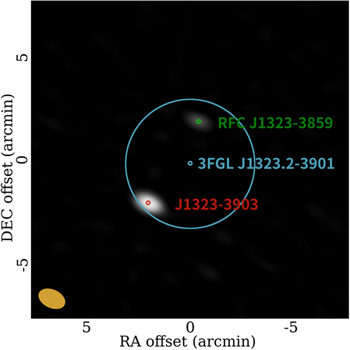| 8th of June 2017 |
|---|

|
| Radio counterparts to unidentified gamma-ray sources |
| by Phil Edwards (CASS) |
| In 2015 a catalog of 3033 sources detected at gamma-ray energies by NASA's Fermi satellite was published. While many of the sources can be associated with bright active galaxies, or pulsars in our galaxy, the catalog contained over 1000 objects for which there was no known counterpart at other wavelengths. A team led by Frank Schinzel of the US National Radio Astronomy Observatory undertook a survey with the Australia Telescope Compact Array (ATCA) and US Very Large Array (VLA) to search for radio counterparts to the unassociated gamma-ray sources. As there was often more than one radio source within the region of the gamma-ray source, observations using the Very Long Baseline Interferometry (VLBI) technique were undertaken with the Australian Long Baseline Array (including the ATCA, Parkes, Mopra, Hobart and Ceduna radio-telescopes) and the US Very Long Baseline Array, as gamma-ray sources have been demonstrated to have compact radio structure that can be detected with VLBI. The survey yielded 142 new associations with active galactic nuclei that are gamma-ray sources, provided alternative associations for seven objects, and improved positions for another 144 known associations to the milliarcsecond level of accuracy. For 245 unassociated gamma-ray sources no compact radio source (above a flux density of 2 mJy) was found, indicating the gamma-ray source is relatively radio-quiet. A further 36 extended radio sources were found that are candidates for association with a corresponding gamma-ray object, 19 of which are most likely supernova remnants or ionized HII regions in our Galaxy, whereas 17 could be radio galaxies. The image above shows a field observed with ATCA at 5.5 GHz centered on the gamma-ray source 3FGL J1323.2-3901. The ATCA observations identified two sources, J1323-3859 and J1323-3903 as candidates for association. VLBI follow-up observations at 8 GHz revealed compact emission only from the weaker source J1323-3859, and thus discriminated against the other candidate. The filled circle in the lower left corner indicates the size of the synthesized beam of the radio observation. The results have been published in the paper "Radio Follow-up on All Unassociated Gamma-Ray Sources from the Third Fermi Large Area Telescope Source Catalog" by Schinzel, Petrov, Taylor and Edwards in the Astrophysical Journal (vol. 838, article 139). |